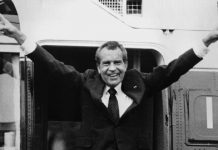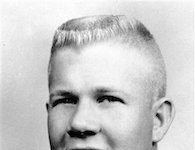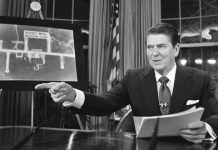On February 26, 1993, Islamic terrorists detonated a car bomb in the World Trade Center’s basement garage, killing six and injuring more than 1,000.
Explosion at the Twin Towers
At 12:18 on a Friday afternoon there was an explosion in a parking garage beneath the North Tower of New York’s World Trade Center. The blast left a 150-by-130-foot-wide crater and collapsed several steel-reinforced concrete floors. Six people died, most believed to have been crushed by collapsing walls, while more than 1,000 were injured.
Within hours, 50,000 people evacuated the Trade Center complex. Streets, bridges and subways in Lower Manhattan were closed. With antennas atop the Twin Towers disrupted, New York television stations went silent.
Initially, authorities suspected that a transformer had exploded near the Vista Hotel, located between the North and South Towers. However, closer inspection showed that the damage was too severe for it to have been caused by a transformer explosion.
Fire Captain Timothy F. Dowling described his survey of the parking garage: “The B-2 level was devastated. Dozens of cars were crushed, thrown about, and fully involved in fire. Walls and ceilings had collapsed. The piping containing electrical wiring was down…The extent and nature of the damage made it evident that someone had exploded a bomb on the B-2 level.”
Many New Yorkers became fearful as rumors of other bomb attacks spread throughout the city; false bomb threats were made against the Empire State Building, Port Authority Terminal and other buildings. “People were saying, ‘Is it Bosnia? Somalia? Saddam Hussein?’” said one tourist to The New York Times. “Then it was, like, ‘What’s next? The Chrysler Building?’”
Related Content
- The War on Terror
- Attack on Pearl Harbor
- LA Times Building Bombing
- Oklahoma City Bombing
- Atlanta Olympic Park Bombing
Discovery of the Bomb Plot and Conviction of Perpetrators
An investigation conducted in the ensuing days confirmed suspicions that the explosion was caused by a bomb. Explosives experts found evidence of urea nitrate, a fertilizer-based explosive, and estimated that the bomb contained between 1,200 and 1,500 pounds of the substance. They extrapolated that the bomb must have been transported in a van or truck, rather than a smaller car.
FBI agents discovered a vehicle identification plate and found that it belonged to a rented van that had reported been stolen from a Ryder rental center in New Jersey the day before the explosion. On March 4, the FBI arrested a suspect, Islamic fundamentalist Mohammad Salameh, when he tried to reclaim his $400 van rental deposit.
Authorities soon arrested three more suspects in New Jersey: Nidal Ayyad, Mahmoud Abouhalima, and Ahmed Aja. They could not find the mastermind of the attack, Ramzi Yousef, who had fled to Iraq just hours after the bomb exploded.
Yousef had intended for the bomb to collapse the North Tower and for debris from the tower to knock over the South Tower. “Had the attack gone as planned, tens of thousands of Americans would have died,” wrote Laurie Mylroie in The National Interest. “Instead, as we know, one tower did not fall on the other, and, rather than vaporizing, the cyanide gas burnt up in the heat of the explosion.”
The conspirators also had links to blind Islamic spiritual leader Sheik Omar Abdel-Rahman, whose planned targets included New York tunnels, bridges, the UN building and the FBI building. He was arrested in June 1993, convicted on conspiracy charges in October 1995, and sentenced to life in prison.
The four captured conspirators were put on trial later that year and convicted on March 4, 1994; each received a life sentence. Yousef remained on the run until February 1995, when he was captured in Pakistan, returned to the United States and later convicted and sentenced to life.
Sources in this Story
- Department of Homeland Security: U.S. Fire Administration/Technical Report Series: The World Trade Center Bombing: Report and Analysis (PDF)
- The New York Times: Explosion at the Twin Towers
- FBI: First Strike: Global Terror in America
- Federation of American Scientists (The National Interest): Who is Ramzi Yousef? And Why It Matters
- The Washington Post (AP): WTC Bombing Ended Age of Innocence
- CBS: 1st Trade Center Attack: 10 Years Ago
The September 11 Attacks
The World Trade Center attack signaled the threat of Islamic terrorism in the United States. “The days before the bomb blast appear to mark the last time when millions of Americans went about their business, unaware of the dangers posed by international terrorism,” writes Larry Neumeister of The Associated Press.
On the morning of September 11, 2001, the World Trade Center was again attacked by Islamic extremists. Nineteen members of al-Qaida, the terrorist organization headed by Osama bin Laden, hijacked four commercial airplanes, two of which were flown into the Twin Towers. Both towers collapsed within hours of being struck; nearly 3,000 people were killed in the attacks.
New York Police Commissioner Raymond Kelly told AP in 2003 that the United States did not take the threat of terrorism seriously enough in the wake of the 1993 attack. “It should have been a wake-up call for America,” he said. “We simply didn’t see it as an international conspiracy to destroy our society.”











